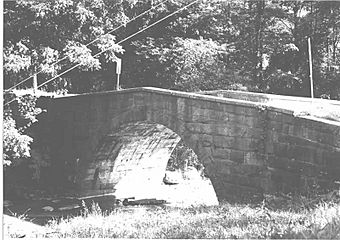Bridge in West Wheatfield Township facts for kids
Quick facts for kids |
|
|
Bridge in West Wheatfield Township
|
|

Bridge in West Wheatfield Township, 1982
|
|
| Nearest city | Legislative Route 32008 over Richards Run, northeast of Robinson, West Wheatfield Township, Pennsylvania |
|---|---|
| Area | less than one acre |
| Built | 1911 |
| Architectural style | Single span camelback arch |
| MPS | Highway Bridges Owned by the Commonwealth of Pennsylvania, Department of Transportation TR |
| NRHP reference No. | 88000774 |
| Added to NRHP | June 22, 1988 |
The Bridge in West Wheatfield Township is a cool old stone bridge with a special arch shape. You can find it in West Wheatfield Township, which is in Indiana County, Pennsylvania.
This bridge was built a long time ago, in 1911. It's about 75 feet (23 meters) long. The main arch of the bridge stretches 30 feet (9 meters) across. It's made from rough, rocky stones and has a concrete wall, called a parapet, along its sides. The bridge crosses over a stream named Richard's Run.
It's so special that it was added to the National Register of Historic Places in 1988. This means it's recognized as an important historical landmark!
What Makes This Bridge Special?
The Bridge in West Wheatfield Township is a type of bridge called a "stone arch bridge." This means it uses a curved arch to hold up the road above it. Arch bridges are very strong because they spread the weight out evenly.
This particular bridge has a "semi-circular arch." This means the arch forms half of a perfect circle. It's a classic design that has been used for centuries.
How Was the Bridge Built?
Building a stone bridge like this in 1911 was a big job! Workers had to carefully cut and shape each stone. They then fit them together without using much, if any, cement between the main stones. The rough, rock-faced stones give the bridge a natural and sturdy look. The concrete parapet, or low wall, on the sides helps keep people and vehicles safe.
Why is This Bridge Important?
The bridge is important because it shows how bridges were built over 100 years ago. It's a great example of early 20th-century engineering. Being on the National Register of Historic Places means it's protected and recognized for its historical value. It reminds us of the past and how people traveled and built things in Pennsylvania.



